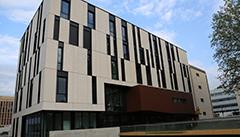
Sciences & Société
Soutenance de thèse : Florian TEZENAS DU MONTCEL
Nonlinear rotordynamics of a vibroflot and granular soil interactions during vibro compaction
Doctorant : Florian TEZENAS DU MONTCEL
Laboratoire INSA : LaMCos
École doctorale : ED162 : Mécanique, Énergétique, Génie Civil, Acoustique de Lyon
Vibro compaction is a ground improvement technique which aims to deeply densify sandy soil in order to make stable future infrastructure built on it. Loose soil can be compacted through insertion of vibrating probes, called vibroflots, together with a large volume of water. This enables the sand particles to rearrange themselves in a denser formation and thus increases the overall density of the soil.
Since its invention in the 1930s, the vibro compaction knowledge is mainly based on empirical operational experience, but not on well-founded scientific studies based around fundamentals. This work aims at better understanding how the vibroflot behaves underground and at globally improve the efficiency of the technique. To do so, experimentation and numerical modelling are both implemented.
During site trials the whole process is instrumented to measure the vibroflot - soil system dynamics, which allow to understand the different phenomena involved during compaction. Many geotechnical tests, combined with different sets of execution parameters, permit to quantify soil improvement and define the influence of these parameters, judge the relevancy of geotechnical correlations and get soil parameters which are useful for numerical modelling. Indeed, a multi- physics numerical model is created to predict the dynamic behaviour of the vibroflot in interaction with a granular soil. Models of the induction motor, multi-rotor and soil are strongly coupled but do not predict the compaction rate: the objective is to study the vibroflot dynamics rather than the compaction phenomenon. Key parts of the vibroflot, the dynamic properties of the rubber couplings are determined experimentally and numerically. Simple analytical formulations of the equivalent stiffness and damping parameters are then used in the numerical model. Finally, predicted responses are compared to the measurements collected on site.
Additional informations
-
Amphithéâtre Clémence Royer (bâtiment Jacqueline Ferrand) - INSA Lyon (Villeurbanne)

